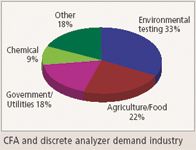Continuous Flow Analysis and Discrete Analyzers
In continuous flow analysis (CFA), a sample is injected into a flowing carrier solution passing rapidly through small-bore tubing. The sample is mixed with a reagent, which reacts with the sample to develop a color and determine the sample concentration. The use of carefully controlled flow conditions ensures that the color development reaction is reproducible, so that the color measurement need not wait until the reaction has gone to completion.
In continuous flow analysis (CFA), a sample is injected into a flowing carrier solution passing rapidly through small-bore tubing. The sample is mixed with a reagent, which reacts with the sample to develop a color and determine the sample concentration. The use of carefully controlled flow conditions ensures that the color development reaction is reproducible, so that the color measurement need not wait until the reaction has gone to completion.

CFA and discrete analyzer demand industry
There are several technologies of CFA such as segmented flow analysis (SFA), which uses turbulent flow conditions that allow for complete sample dispersion. Other technologies include flow injected analysis (FIA) and sequential injection analysis, which uses laminar flow existing in the narrow-bore tubing to mix with the reagent to eliminate the need for air bubble partitioning.
In contrast to CFA, discrete analyzers keep sample separate throughout the testing process, dispensing precise amounts when required. Rotating individual cuvettes through the instrument instead of releasing the sample in a continuous stream cuts down on reagent waste, and can produce hundreds of results per hour.
CFA and discrete analyzers are used in environmental applications for measuring analytes like ammonia, chloride, nitrite, phosphate, etc. The systems also are used in food and beverage, chemical testing, and pharmaceutical laboratories. Although CFA is a well-established technique for industrial applications, the prospect of cutting testing and consumable costs, along with the ease of operation have prompted many laboratories to transfer methods from CFA to discrete analyzers.
The foregoing data was extracted and adapted from SDi's Global Assessment Report, 9th Edition. For more information, contact Glenn Cudiamat, VP of Research Services, Strategic Directions International, Inc., 6242 Westchester Parkway, Suite 100, Los Angeles, CA 90045, (310) 641-4982, fax: (310) 641-8851, e-mail: cudiamat@strategic-directions.com

Regulatory Deadlines and Supply Chain Challenges Take Center Stage in Nitrosamine Discussion
April 10th 2025During an LCGC International peer exchange, Aloka Srinivasan, Mayank Bhanti, and Amber Burch discussed the regulatory deadlines and supply chain challenges that come with nitrosamine analysis.
Top Execs from Agilent, Waters, and Bruker Take the Stage at J.P. Morgan Healthcare Conference
January 16th 2025The 43rd Annual Healthcare J.P. Morgan Healthcare Conference kicked off in San Francisco earlier this week. Here’s what top executives from Agilent, Bruker, and Waters, discussed during the event.

.png&w=3840&q=75)

.png&w=3840&q=75)



.png&w=3840&q=75)



.png&w=3840&q=75)





